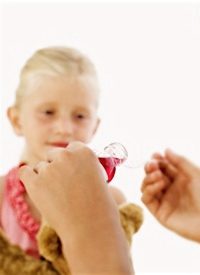
Are parents unintentionally over-dosing their children with over-the-counter (OTC) medicines? Apparently only costly studies by professionals at medical schools can answer that question, and, of course, only the Food and Drug Administration (FDA) can remedy whatever problem might exist.
Indeed, a study from the School of Medicine at New York University has found that many parents and guardians are unintentionally over-medicating the children under their care on OTC liquid meds because manufacturers are making the directions too difficult and are not providing fail-proof utensils to administer the medicines.
According to the Centers for Disease Control (CDC), about one-third of all emergency room visits for children under 12 involve over-the-counter medication, with the CDC saying that every year around 70,000 children under 18 are taken to the ER for overdoses.
The NYU study sampled 200 of the most popular over-the-counter cold, allergy, analgesic, and gastro-intestinal liquid medicines for kids, and found significant inconsistencies between the recommended dosages indicated on the labels and the measuring appliance provided for the parents to administer the meds to their children.
In fact, noted the report published in the December 1 issue of the Journal of the American Medical Association (JAMA), one in four of the meds didn’t even include a spoon for measuring the dose, despite (voluntary) recommendations made in 2009 by the FDA that all children’s medicines include such a device. The study, which was conducted at about the time the guidelines went into effect, documented broad inconsistencies in packaging and directions among the predominant OTC liquid children’s medications.
“There is an unacceptable amount of inconsistency in labels and measuring devices of OTC liquid medications for children,” said Dr. H. Shonna Yin, a professor of pediatrics at NYU School of Medicine and co-leader of the study. “These types of inconsistencies are likely to be a source of confusion for parents and can lead to errors in dosing, placing children at risk.”
Of the medicines sampled in the study, nearly 97 percent included at least one inconsistency between the directions on the medicine label and the dosage markings on the utensil provided to administer the medicine. “Among the measuring devices, 81.1 percent included one or more superfluous markings,” the study’s authors wrote. “The text used for units of measurement was inconsistent between the product’s label and the enclosed device in 89 percent of products. A total of 11 products … used non-standard units of measurement, such as drams, cubic centimeters, or fluid ounces, as part of the doses listed.”
Another of the study’s authors, Dr. Ruth Parker of the Emory University School of Medicine, warned that the labeling problems were compromising patient safety and that “urgent attention” was required. “Given how many products are affected, it seems unlikely that the voluntary guidelines alone set by the FDA and industry will fix this problem,” she warned, a comment suggesting that the industry would not be able to implement a standardized system of directions and measurement without the involvement of the federal government. “The current guidance does not contain a timeline for compliance or specify consequences for non-compliance,” she said, adding that “standards and regulatory oversight will likely be needed to ensure that all products contain label information and dosing device markings that match and are understandable and useful.”
Expanding on the nature of the problem, which has apparently existed for decades but is only now coming to light and being addressed, Dr. Yin explained, “Devices often have extra markings on them that are not listed on the label, which can be distracting and lead to confusion. Furthermore, some devices are missing doses that are recommended on the label, making the task of dosing more difficult.”
Yin said that requiring medicine manufacturers to match dosage instructions and devices to the same measurements and terminology would aid parents and guardians in accurately administering the medicines they give to children. One of the recommendations made by the researchers was for the required inclusion of a standardized dosing device in every package of liquid children’s medicine, in addition to directions containing consistent directions for all products.
The study was conducted in cooperation with both the FDA and the Consumer Healthcare Products Association (CHPA), a trade organization representing over 90 percent of the manufacturers of OTC medicines. While the industry obviously didn’t count on a new layer of FDA-imposed laws coming out of its cooperation with the study, this is apparently the direction things are headed. “The plan is to take another look in a year or so to see if changes have been made, said Dr. Yin, with the FDA perhaps stepping in more forcefully if the industry does not shape up. The CHPA said that while its member were cooperating to bring their products up to FDA guidelines, changes would take some time to be reflected uniformly in updated packaging and more specific dosage directions.
Yin said one of the concerns of the study’s authors “is that because so many products are implicated, a voluntary guideline may not be a strong enough step. It is great that both the CHPA and the FDA recognize that these are important issues, but I am not sure that the voluntary guidelines will be able to fix such a big problem. The FDA may need to set official standards and regulate these products to ensure compliance.”



